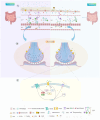Progresses in Questing for the Truth of Opioid-Related Constipation in Cancer Patients
- PMID: 40281681
- PMCID: PMC12031673
- DOI: 10.1111/jcmm.70553
Progresses in Questing for the Truth of Opioid-Related Constipation in Cancer Patients
Abstract
Opioids are extensively utilised to manage pain in cancer patients, but may cause constipation which significantly impacts their prognosis and quality of life. Opioid-induced constipation (OIC) lacks effective drugs and management strategies. Opioids act on the enteric nervous system, intestinal barrier, intestinal immunity and intestinal microbiota, implying that OIC is a multifactorial process. This paper aims to examine the effects of opioids on the intestine, specifically the enteric nervous system, intestinal barrier and interstitial cells of Cajal (ICCs), and elucidate the primary mechanisms underlying OIC development and deterioration. This review suggests that enteric neurons, intestinal immunity and intestinal flora could serve as potential therapeutic targets for OIC.
Keywords: cancer; constipation; enteric nervous system; intestinal cells of Cajal; intestinal flora; opioid.
© 2025 The Author(s). Journal of Cellular and Molecular Medicine published by Foundation for Cellular and Molecular Medicine and John Wiley & Sons Ltd.
Conflict of interest statement
The authors declare no conflicts of interest.
Figures

Similar articles
-
[Opioid-induced constipation: Update on management and treatment].Bull Cancer. 2025 Apr;112(4):425-434. doi: 10.1016/j.bulcan.2025.01.007. Epub 2025 Feb 25. Bull Cancer. 2025. PMID: 40011141 Review. French.
-
Opioid-Induced Constipation in Oncological Patients: New Strategies of Management.Curr Treat Options Oncol. 2019 Dec 19;20(12):91. doi: 10.1007/s11864-019-0686-6. Curr Treat Options Oncol. 2019. PMID: 31853656 Free PMC article. Review.
-
[Opioid-Induced Constipation in Patients with Cancer Pain].Gan To Kagaku Ryoho. 2021 Nov;48(11):1311-1315. Gan To Kagaku Ryoho. 2021. PMID: 34795117 Japanese.
-
Efficacy of prophylactic laxatives against opioid-induced constipation: retrospective propensity score matching analysis.Support Care Cancer. 2025 Jan 21;33(2):115. doi: 10.1007/s00520-025-09154-w. Support Care Cancer. 2025. PMID: 39836290 Free PMC article.
-
Effects of Electroacupuncture for Opioid-Induced Constipation in Patients With Cancer in China: A Randomized Clinical Trial.JAMA Netw Open. 2023 Feb 1;6(2):e230310. doi: 10.1001/jamanetworkopen.2023.0310. JAMA Netw Open. 2023. PMID: 36811861 Free PMC article. Clinical Trial.
References
Publication types
MeSH terms
Substances
Grants and funding
LinkOut - more resources
Full Text Sources
Medical

